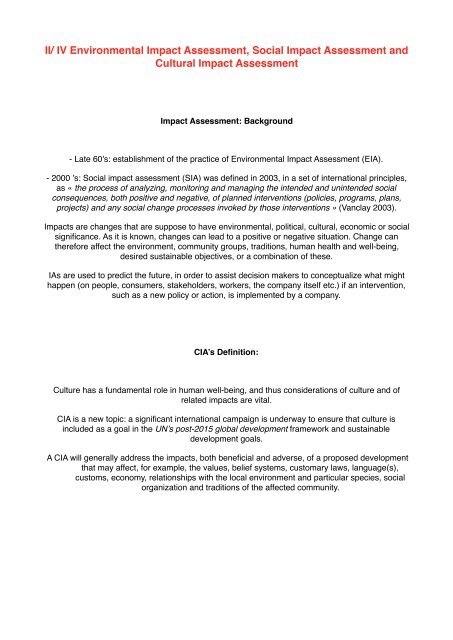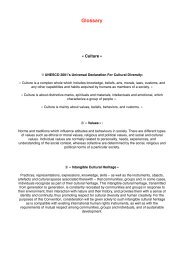Awareness Trainings - Draft #1
You also want an ePaper? Increase the reach of your titles
YUMPU automatically turns print PDFs into web optimized ePapers that Google loves.
II/ IV Environmental Impact Assessment, Social Impact Assessment and<br />
Cultural Impact Assessment<br />
Impact Assessment: Background<br />
- Late 60’s: establishment of the practice of Environmental Impact Assessment (EIA).<br />
- 2000 ’s: Social impact assessment (SIA) was defined in 2003, in a set of international principles,<br />
as « the process of analyzing, monitoring and managing the intended and unintended social<br />
consequences, both positive and negative, of planned interventions (policies, programs, plans,<br />
projects) and any social change processes invoked by those interventions » (Vanclay 2003).<br />
Impacts are changes that are suppose to have environmental, political, cultural, economic or social<br />
significance. As it is known, changes can lead to a positive or negative situation. Change can<br />
therefore affect the environment, community groups, traditions, human health and well-being,<br />
desired sustainable objectives, or a combination of these.<br />
IAs are used to predict the future, in order to assist decision makers to conceptualize what might<br />
happen (on people, consumers, stakeholders, workers, the company itself etc.) if an intervention,<br />
such as a new policy or action, is implemented by a company.<br />
CIA’s Definition:<br />
Culture has a fundamental role in human well-being, and thus considerations of culture and of<br />
related impacts are vital.<br />
CIA is a new topic: a significant international campaign is underway to ensure that culture is<br />
included as a goal in the UN’s post-2015 global development framework and sustainable<br />
development goals.<br />
A CIA will generally address the impacts, both beneficial and adverse, of a proposed development<br />
that may affect, for example, the values, belief systems, customary laws, language(s),<br />
customs, economy, relationships with the local environment and particular species, social<br />
organization and traditions of the affected community.




